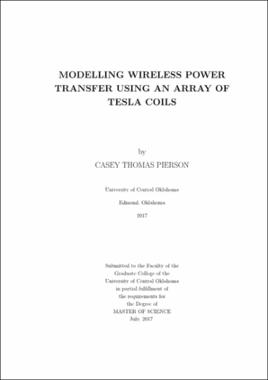| dc.contributor.advisor | Wilson, Weldon | |
| dc.contributor.author | Pierson, Casey Thomas | |
| dc.date.accessioned | 2020-07-09T14:39:56Z | |
| dc.date.available | 2020-07-09T14:39:56Z | |
| dc.date.issued | 2017 | |
| dc.identifier.other | (AlmaMMSId)9982547581202196 | |
| dc.identifier.uri | https://hdl.handle.net/11244/325036 | |
| dc.description.abstract | Wireless power transmission, or WPT, is a well-demonstrated property in electrical science and physics. Coil-and-wave transmission (CWT) consists of two Tesla coils, one powered by a controlled voltage source v src and one connected across a generic load Z 0 , at a mid- to long range distance apart with spherical capacitors at each of their top loads. The literature on the different methods of WPT varies widely, but research of CWT is sparse, lacking especially in the area of computer simulation. Recently, a physical experiment was conducted by Marzolf et al. in [1], and yielded surprising resonant frequencies in the high frequency range. The goal of this research is to answer the question of whether these reosnant frequencies originate in unexplained field effects or in non-ideal circuit behavior, and establish a formal model to indicate at what frequencies the resonant peaks occur as a first approximation. By carefully constructing a simulation of the most geometrically simple, power efficient design in the work of Marzolf et al. using the scientific software Octave, we investigate these frequencies computationally: first, an ideal scenario that has no flux leakage or exterior losses is modelled mathematically and simulated, and then, a non-ideal scenario that accounts for losses in the coils and surroundings is modelled mathematically and simulated. Both models utilize a simple formula for spherical capacitance for the top loads. After running these simulations through detailed sampling up to 4 MHz, the ideal model could not account for the resonant peaks, while the non-ideal model indicated the resonant peaks near the exact frequency ranges that were observed. An unexpected characteristic of these results was that coupling coefficients between the coils of the transmitter and receiver played a noticeable part in the indication of resonant peaks. This demonstrates that unknown field effects are not the primary driver of resonance in the ideal or non-ideal construction, and raises inriguing questions about the circuit design's relationship with resonance in the locality about the coils. | |
| dc.rights | All rights reserved by the author, who has granted UCO Chambers Library the non-exclusive right to share this material in its online repositories. Contact UCO Chambers Library's Digital Initiatives Working Group at diwg@uco.edu for the permission policy on the use, reproduction or distribution of this material. | |
| dc.subject.lcsh | Wireless power transmission | |
| dc.subject.lcsh | Electric power transmission | |
| dc.subject.lcsh | Tesla coils | |
| dc.subject.lcsh | Physics | |
| dc.subject.lcsh | Engineering | |
| dc.title | Modelling wireless power transfer using an array of Tesla coils. | |
| dc.type | Academic theses | |
| dc.contributor.committeeMember | Moussa, Abdellah Ait | |
| dc.contributor.committeeMember | Bingabr, Mohamed | |
| dc.thesis.degree | M.S., Engineering Physics | |
| dc.subject.keywords | Field | |
| dc.subject.keywords | Model | |
| dc.subject.keywords | Physics | |
| dc.subject.keywords | Simulation | |
| dc.subject.keywords | Transmission | |
| dc.subject.keywords | Wireless Power | |
| dc.identifier.oclc | (OCoLC)on1005355670 | |
| uco.group | UCO - Graduate Works and Theses::UCO - Theses | |
| thesis.degree.grantor | Jackson College of Graduate Studies. | |
